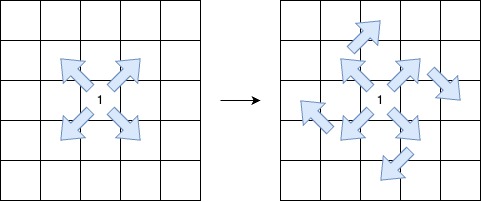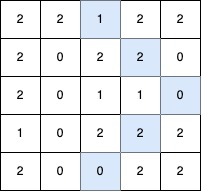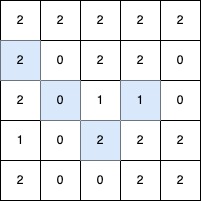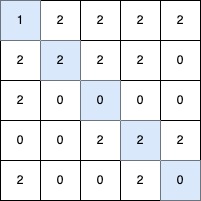3459. Length of Longest V-Shaped Diagonal Segment
Description
You are given a 2D integer matrix grid of size n x m, where each element is either 0, 1, or 2.
A V-shaped diagonal segment is defined as:
- The segment starts with
1. - The subsequent elements follow this infinite sequence:
2, 0, 2, 0, .... - The segment:
- Starts along a diagonal direction (top-left to bottom-right, bottom-right to top-left, top-right to bottom-left, or bottom-left to top-right).
- Continues the sequence in the same diagonal direction.
- Makes at most one clockwise 90-degree turn to another diagonal direction while maintaining the sequence.

Return the length of the longest V-shaped diagonal segment. If no valid segment exists, return 0.
Example 1:
Input: grid = [[2,2,1,2,2],[2,0,2,2,0],[2,0,1,1,0],[1,0,2,2,2],[2,0,0,2,2]]
Output: 5
Explanation:

The longest V-shaped diagonal segment has a length of 5 and follows these coordinates: (0,2) → (1,3) → (2,4), takes a 90-degree clockwise turn at (2,4), and continues as (3,3) → (4,2).
Example 2:
Input: grid = [[2,2,2,2,2],[2,0,2,2,0],[2,0,1,1,0],[1,0,2,2,2],[2,0,0,2,2]]
Output: 4
Explanation:

The longest V-shaped diagonal segment has a length of 4 and follows these coordinates: (2,3) → (3,2), takes a 90-degree clockwise turn at (3,2), and continues as (2,1) → (1,0).
Example 3:
Input: grid = [[1,2,2,2,2],[2,2,2,2,0],[2,0,0,0,0],[0,0,2,2,2],[2,0,0,2,0]]
Output: 5
Explanation:

The longest V-shaped diagonal segment has a length of 5 and follows these coordinates: (0,0) → (1,1) → (2,2) → (3,3) → (4,4).
Example 4:
Input: grid = [[1]]
Output: 1
Explanation:
The longest V-shaped diagonal segment has a length of 1 and follows these coordinates: (0,0).
Constraints:
n == grid.lengthm == grid[i].length1 <= n, m <= 500grid[i][j]is either0,1or2.
Solutions
Solution: Dynamic Programming
- Time complexity: O(8mn -> mn)
- Space complexity: O(8mn -> mn)
JavaScript
/**
* @param {number[][]} grid
* @return {number}
*/
const lenOfVDiagonal = function (grid) {
const m = grid.length;
const n = grid[0].length;
const directions = [
[1, 1],
[1, -1],
[-1, -1],
[-1, 1],
];
const dp = new Array(m * n * 4 * 2).fill(-1);
let result = 0;
const getVDiagonalSegment = (row, col, dir, turned, target) => {
if (row < 0 || col < 0 || row >= m || col >= n) return 0;
if (grid[row][col] !== target) return 0;
const hashKey = ((row * n + col) * 4 + dir) * 2 + turned;
if (dp[hashKey] !== -1) return dp[hashKey];
const [moveRow, moveCol] = directions[dir];
const nextRow = row + moveRow;
const nextCol = col + moveCol;
const nextValue = target ? 0 : 2;
let maxSegment = 1 + getVDiagonalSegment(nextRow, nextCol, dir, turned, nextValue);
if (!turned) {
const turnDir = (dir + 1) % 4;
const [moveRow, moveCol] = directions[turnDir];
const turnRow = row + moveRow;
const turnCol = col + moveCol;
const len = 1 + getVDiagonalSegment(turnRow, turnCol, turnDir, 1, nextValue);
maxSegment = Math.max(len, maxSegment);
}
dp[hashKey] = maxSegment;
return maxSegment;
};
for (let row = 0; row < m; row++) {
for (let col = 0; col < n; col++) {
if (grid[row][col] !== 1) continue;
for (let index = 0; index < 4; index++) {
const [moveRow, moveCol] = directions[index];
const nextRow = row + moveRow;
const nextCol = col + moveCol;
const len = 1 + getVDiagonalSegment(nextRow, nextCol, index, 0, 2);
result = Math.max(len, result);
}
}
}
return result;
};